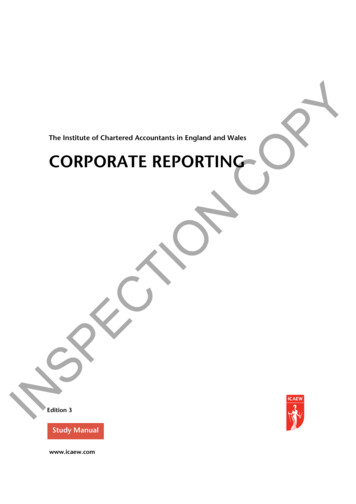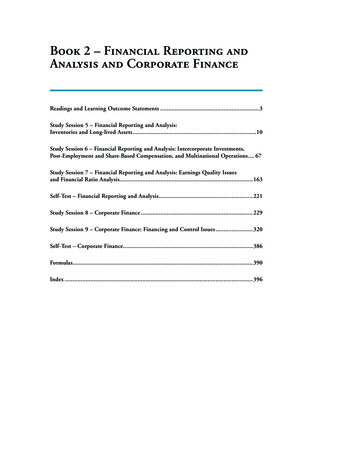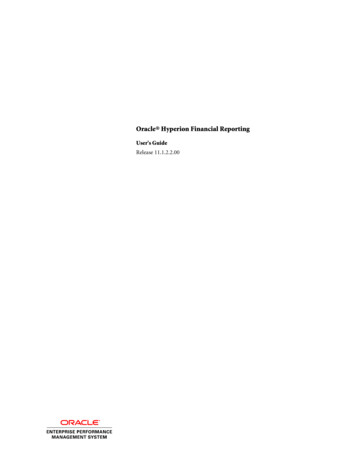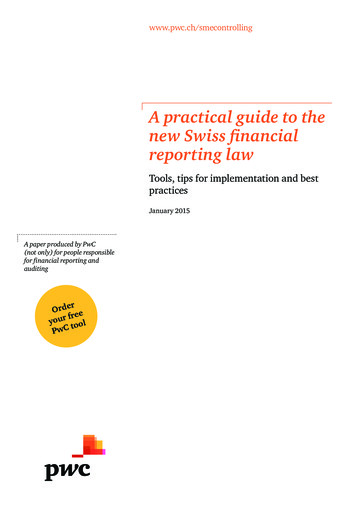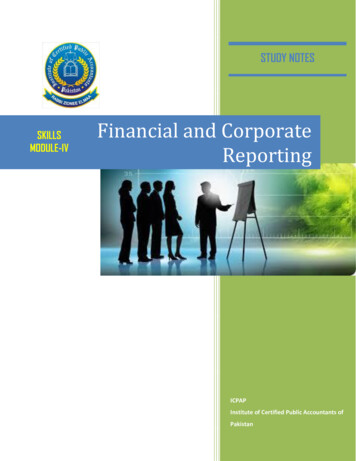
Transcription
STUDY NOTESSKILLSMODULE-IVFinancial and CorporateReportingICPAPInstitute of Certified Public Accountants ofPakistan
Financial and Corporate ReportingICPAPTable of Contents1Introduction2 Corporate Financial Reporting System2.1 Concept of Corporate Financial Reporting2.2. Users of Financial Statements:2.3. Objectives of Corporate Financial Reporting2.4. Capital Market and Non – Financial Influences on Corporate Financial Reporting:2.5. Qualitative Characteristics of Information in Financial Report2.5.1 Understandability2.5.2 Relevance2.5.3 Reliability2.5.4 Comparability2.6 Theories of Disclosure2.6.1 Concept of Disclosure2.6.2 Motives Behind Disclosure2.6.3 Basic Problems of Disclosure2.7 Role of Auditors2.8 Quality of Financial Reporting2.9 Mode of Financial Reporting3. Pakistan Financial Reporting System3.1 Role of the SECP3.2 The Companies Ordinance, 19843.2.1 Book of Account3.2.2 Statutory Recognition of Accounting Standards3.2.3 Concept of True and FairPage 1
Financial and Corporate ReportingICPAP3.2.4 Disclosure Requirements under the Companies Ordinance3.2.4.1 Balance Sheet3.2.4.2 Statement of Profit and Loss3.2.4.3 Narrative Disclosures3.2.4.4 Cash Flow Statement3.2.4.5 Supplementary Statements3.2.5 Disclosure Requirements under Listing Agreement and Other SECP Guidelines3.2.5.1 Balance Sheet, Profit and Loss Account and Directors‟ Report3.2.5.2 Cash Flow Statement3.2.5.3 Related Party Disclosure3.2.5.4 Disclosure to be made by holding Companies and Subsidiary Companiesin respect of Loans, Advances and Investments.3.2.5.5 Corporate Governance4. Corporate Reporting Practices in Pakistan:4.1 Published Financial Statement4.2 Abridged form Balance Sheet5. Other Reports5.1 Disclosure of Financial Information in Prospectus5.2 Unaudited Quarterly Results6. The Conceptual Framework7. IAS 1: Presentation of Financial Statements8. Substance and IAS 18 Revenue9. Construction Contracts10. Predictive Value11. IAS 16, 20, 23, 38, 40 Non-Current AssetsPage 2
Financial and Corporate ReportingICPAP12. IAS 36: Impairment of Assets13. IAS 37: Provisions, Contingent Liabilities and Contingent Assets14. IAS 17: Leases15. Financial Instruments16. IAS 12: Taxation17. Group Financial Statements18. Associates19. Statement of Cash Flows20. Interpretation of Accounts and Ration Analysis21. Limitations on Ratios22. Deconsolidation23. Question and AnswersPage 3
Financial and Corporate ReportingICPAP1. IntroductionAn understanding of the conceptual bases of the corporate financing reporting system and thepreparation of financial statement are essential prerequisites to be a good accountant or afinancial analyst. This chapter intends to explain the corporate financial reporting system andissues involved. Regulatory framework of corporate financial reporting in Pakistan andpractices of Pakistan Companies are also covered. In the last section reporting issues relating tomatters that are reported outside the general purpose financial statements are considered.2 Corporate Financial Reporting SystemThis chapter discusses the conceptual issues of corporate financial reporting. Disclosures beinga major aspect of financial reporting, theories of disclosure have also been considered. Issuesrelating to quality of financial reporting and mode of financial reporting have also been dealtwith.2.1. Concept of Corporate Financial Reporting: Financial reporting is the communication offinancial information of an enterprise to the external world. Bedford conceptualizes thefinancial reporting process as consisting of four procedural steps:1. Perception of the significant activity of the accounting entity or in the environment inwhich the entity performs. Implicit in the traditional perception is the belief thatfinancial transactions represent the significant activities.2. Symbolizing the perceived activities in such fashion that a database of the activities isavailable that can then be analyzed to grasp an understanding of the interrelationship ofthe mass of perceived activities. Conventionally, this symbolization has taken the formof recordings in accounts, journals, and ledgers using well – established bookkeepingand measurement procedures.3. Analysis of the model of activities in order to summarize the interrelationships amongactivities and to provide a status picture or map of the entity. Traditionally, this analysisprocess has been viewed as one of developing accounting reports to provide insightsinto the nature or entity activities.4. Communication (transmission) of the analysis to users of the accounting products toguide decision makers in directing future activities of the entity or in changing theirrelationship with the entity.First two steps constitute the process of accounting measurement, the quantification of anentity‟s past, and present, or future economic phenomena on the basis of observations andrules. Implicit in this conception are the requirements that (a) there exist some attribute orfeature of a business – related objects or event (e.g.: the value of an asset) worthy ofmeasurement and (b) there exist a means of making the measurements (e.g., the use of exchangeprices to value enterprise assets). Step 3 and 4 of the financial reporting process constitutePage 4
Financial and Corporate ReportingICPAPdisclosure. Hence, measurement and disclosure are two dimensions of reporting process andthese two aspects are interrelated. Together, they give corporate reporting its substance.Corporate financial reporting is a series of activities that allows companies to record operatingdata and report accurate accounting statements at the end of each month, quarter and year.Bookkeepers record operating data by debiting and crediting financial accounts. Accountantsprepare financial statements in accordance with corporate policies, industry practices andregulatory guidelines.Corporate financial reporting is an important function because it enables organizations topresent accurate accounting statements. Within a corporate context, financial reporting coversset of accounting data which include1. Balance Sheet (or statement of financial position).2. Profit & Loss Account (or statement of earnings or income statement).3. Cash Flow Statement (or statement of cash flows).Balance SheetA corporate balance sheet is also known as a statement of financial condition or statement offinancial position. It provides information about a company‟s assets, liabilities and equitycapital. Assets are economic resources that a company owns. Liabilities are debts anorganization must repay. Equity capital represents funds that financial market participantsinvest in a company.Income StatementAn organization‟s income statement is an important report on which investors, financialanalysts and corporate business partners rely to gauge a company‟s economic health. A treasuretrove of corporate information, this statement provides data on a firm‟s expenses and revenues,indicating whether the firm is profitable or not. A company‟s business partners includesuppliers, customers and lenders.Cash Flow StatementA cash flow statement indicates liquidity movements within a company‟s operations. In otherwords, the report tells the tale of the company‟s cash payments and receipts over a period oftime. The statement indicates (in this order): cash flows from operating activities, cash flowsfrom investing activities and cash flows from financing activities.These three financial statements, augmented by footnotes and supplementary data (oftenreferred to as „Notes on Accounts‟ or „Notes to the Accounts‟ in Pakistan) are intended toprovide relevant, reliable and timely information essential for making investment, credit andsimilar decision. Such financial statements are called general purpose financial statements.Page 5
Financial and Corporate ReportingICPAPIt may be mentioned that the term financial reporting is not restricted to informationcommunicated through financial statements. Financial reporting includes other means ofcommunicating information that relates, directly or indirectly to the information generatedthrough accounting process. Information provided by means of financial reporting other thanfinancial statements may take various forms and relate to various matters. Communication bymeans of financial reporting other than a formal financial statement is made due to regulatoryrequirements or customs. In a few occasions, management may communicate any mattervoluntarily when it considers such communication is useful to the stakeholders outside theenterprise. Publication of unaudited financial results, news releases, management forecasts anddescription of future plans are example of reports that are provided outside the general purposefinancial statements.2.2. Users of Financial Statements: Different classes of user‟s financial information for differentpurposes. Identification of the users and their classes is necessary in order to determine thepurposes for which they use information. Identification of users helps in defining user groupcharacteristics which influence both the specific type of information to be presented and themanner of presentation.According to Framework for the Preparation and Presentation of Financial Statements the usersof financial statements include present and potential investors, employees, lenders, suppliersand other trade creditors, customers, governments and their agencies and the public.The common characteristic of external users in their general lack of authority to prescribe theinformation they want from a company. It is also observed that some users have more resourceand influence than others so that they can obtain more information about an enterprise than isgenerally available to others. These privileged users include mangers, large scale equityinvestors etc. These different users groups have different objectives and diverse informationneeds. But, general purpose financial statements are prepared to meet the common needs of alltypes of users. However, all of the information needs of these users cannot be met by such areport. Multiplicity and conflicts of objectives of a wide variety of potential users for generalpurpose reports make it difficult to design a single set of published statements that cansimultaneously provide all necessary information to all possible users.Traditionally, investors (both existing and potential) are singled out as the dominant user groupof published financial statements. As providers of risk capital to the enterprise, investors needmore comprehensive information than other users. Conceptual Framework states that theprovision of financial statements, which meet the investor‟s needs, will also meet most of theneeds of other users. Also in practice, top priority is given to the information needs of theinvestors while deciding what items of information should be disclosed in general purposefinancial statements.Page 6
Financial and Corporate ReportingICPAP2.3. Objectives of Corporate Financial Reporting: Corporate financing reporting is not an endin itself but is a means to certain objectives. There are debates regarding objective of financialreporting. However, some consensus has been developed on the objectives of financialreporting through the issuance of the conceptual framework. The conceptual frameworkprovides the conceptual basis for generally accepted accounting principles (GAAP). It outlinesthe characteristics accounting information must possess to be useful in investment and othereconomic decisions. Like other standard setting bodies, of the Framework states that theobjective of financial statement is to provide information about financial position, performanceand cash flows of an enterprise that is useful to a wide range of users in making economicdecisions. The Framework specifies present and potential investors, employees, lenders,suppliers and other trade creditors, customers, governments and their agencies and the publicas the users of financial statements.In USA, the FASB has identified the following major objectives of financial reporting:i.ii.iii.iv.v.vi.vii.viii.Financial reporting should provide information that is useful to present and potentialinvestors and creditors and other users in making rational investment, credit and similardecisions.Financial reporting should provide information to help investors, creditors, and other toassess the amount, timing and uncertainly of prospective net cash inflows to the relatedenterprise.Financial reporting should provide information about the economic resources of anenterprise, the claims to those resources (obligations of the enterprise to transferresources to other entities and owners‟ equity), and the effects of transactions, eventsand circumstances that change resources and claims to those resources.Financial reporting should provide information about an enterprise‟s financialperformance during a period.The primary focus of financial reporting is information about an enterprise‟sperformance provided by measures of earnings and its components.Financial reporting should provide information about how an enterprise obtains andspends cash, about its borrowing and repayment of borrowing, about its capitaltransactions, including cash dividends and other distributions of enterprise‟s resourcesto owners, and about other factors that may affect an enterprise‟s liquidity or solvency.Financial reporting should provide information about how management of an enterprisehas discharged its stewardship responsibility to owners (stockholders) for the use ofenterprise resources entrusted to it.Financial reporting should provide information that is useful to managers and directorsin making decisions in the interest of owners.Apart from investment decision making another objective of financial reporting is to provideinformation on management accountability. Management accountability is a broad concept thatPage 7
Financial and Corporate ReportingICPAPencompasses stewardship. The accountability relationship may be created by a constitution, alaw, a contract an organization make, a custom or even by informal moral obligation. It isconsidered that management of an enterprise is periodically accountable to the owners not onlyfor safekeeping of resources but also for their efficient and profitable use. Managementaccountability objective mainly emphasizes reliability aspect of accounting information.Accordingly, compared to relevance, verifiability through adequate documents, records andsystem is considered dominant consideration for inclusion of any piece of information in thefinancial statement.Corporate financial reporting being user oriented and users‟ need of information being notsame, the role of accounting and financial reporting may vary from country to country. But,financial reporting is central to the process of allocation financial resources in capital market.Hence, primary purpose of providing useful information to all users, which help them indecision making, is common in all countries.2.4. Capital Market and Non – Financial Influences on Corporate Financial Reporting: Beforeexamining the financial reporting issue that are bringing complexities in reporting system, abrief sketch the evolution of corporate disclosure may be helpful to understand the frameworkof present corporate financial reporting.Till the quarter of the twentieth century, financial reporting was confined to the stewardshipreporting, i.e., reporting of the wealth and income earned by the owners. With the growth insize, companies need large sums of money to finance extensive productions and distributionactivities. Due to internal financial constraints, companies depend heavily on external capitalmarkets to finance the capital needs. However, investors are seldom in a position to observe ona day – to – day basis, whether saving entrusted to the companies are utilized efficiently andeffectively. Hence, investors expect and are provided with an accounting for the stewardship ofmonies entrusted to the company. Stewardship traditionally refers to the safe keeping ofresources and the execution of plans for conserving and utilizing them. Modern concept ofaccountability of management extends beyond the element of stewardship and coversperformance based issues. The managers of the companies accept the accountability phase oftheir stewardship, or at least recognize in self-interest that disclosure through financialreporting process delegates part of the responsibility for assessing the financial status of thecompany and its performance to the users of financial reporting but, with the growth of thecapital market, the central focus of financial reporting has been shifted from stewardshipreporting to decision – oriented financial reporting.Further, the competition among the companies to obtain external financing at a relativelycheaper rate has impact on corporate disclosure. Companies are now making expandeddisclosure to attract capital in domestic capital market and/or in international market and toreduce the firm‟s cost of capital. There are various research studies that establish that increasedPage 8
Financial and Corporate ReportingICPAPfirm disclosure has definite impact a firm‟s overall cost of capital. Such reduction of cost ofcapital through expanded disclosure has linkage with the theory of behaviour of investors whotake investment decision under uncertainty. Increased disclosure in financial reports improvesthe subjective probability distributions of a security‟s expected returns in the mind of aninvestor by reducing the uncertainty associated with that return stream.Thus, capital market influences are having a major role in sharing the nature of corporatefinancing reporting that is now driven by the consideration of decision usefulness. The objectiveof decisional usefulness has formally been incorporated into the conceptual frameworks for thepreparation and presentation of financial statements set out by the standard setting bodies ofdifferent countries as well as by the International Accounting Standards Committee.Apart from accountability to shareholders, there is a growing worldwide trend of holdingcompanies accountable to the public at large. Such a trend is responsible for changing thedisclosure practice of companies to a considerable extent. Such a movement is creatingcompanies aware about the disclosure needs of “non – financial shareholders” such as tradeunions (interested in terms of employment), government (interested in the macroeconomicimpact of operations of corporate sector) and general public (interested in social andenvironmental impact of corporate actions). Voluntary reporting of employee information,environmental information and other corporate social responsibility reports (e.g. social balancesheet) are example of disclosure arising from non – financial influences. Corporate responses tosuch expanded disclosure requirements are mixed. However, it is desirable that financialreporting should cater needs of all type of users.2.5. Qualitative Characteristics of Information in Financial Report: Information, which isreported to facilitate economic decisions, should possess certain qualitative characteristics.Qualitative characteristics are the attributes that make the information provided in the financialstatement useful to the users. Conceptual Framework earmarks four principal qualitativecharacteristics viz., understandability, relevance, reliability and comparability. According to theConceptual Framework, materiality is not a principal qualitative characteristic. A piece ofinformation is considered to be material when its disclosure on non – disclosure would affectdecision or would make a difference in the valuation of the firm. But, in the ConceptualFramework, materiality is considered as a threshold limit, which needs to be judged beforereferring to any other qualities of any information provided in financial statements. If any pieceof information does not fulfill the threshold criteria, it need not be considered further.2.5.1 Understandability: Information is annual reports should be presented in such a way that itis readily understandable by users. Conceptual Framework states that the criterion ofunderstandability requires that the users have a reasonable knowledge of business andeconomic activities, accounting, and a willingness to study the information with reasonablediligence. It has also suggested that information, which is relevant to the economic decisionPage 9
Financial and Corporate ReportingICPAPmaking needs of users should not be excluded merely on the ground that it may be difficult forcertain users to understand.2.5.2 Relevance: The concept of relevance is directly related to the decision making needs ofusers. Information is said to be relevant if it can influence „the economic decisions of users byhelping them evaluate past, present or future events or confirming or correcting, their pastevaluation. It is suggested that all those items of information, which may aid the users inmaking predictions or decisions, should be reported. Information, which does not assist users inmaking decisions is irrelevant and hence, should be omitted. Thus, relevance is the dominantcriterion of taking decisions regarding information disclosure. Timeliness is an important aspectof relevance. Information loses value rapidly in the financial world. As time passes and thefuture becomes the present, past information became increasingly irrelevant.2.5.3 Reliability: Reliability is another important characteristic of information disclosed.Reliability of information is important to users because it influences their decisions. Reliabilityencompasses representational faithfulness, verifiability and neutrality. Information is reliable ifit is free from material error and bias, and faithfully represents what it purports to present.Information is reliable to the extent a user can depend upon it to represent the economicconditions or events that it aims to represent. Being free from bias implies impartialmeasurement and reporting by enterprise of tis events and transactions.It is the responsibility of management to report reliable information in annual reports.However, reliability of information differs from item to item. Some item of informationpresented in annual reports may be more reliable than others.Unfortunately, relevance and reliability are likely to be opposing qualities. For example, theaudit process increases the reliability of financial data, but timeliness and consequently,relevance is worsened. Similarly, a conflict may arise in achieving the objectives or relevanceand reliability for certain pieces of information in the annual reports. It is argues that economicdecision making orientation of corporate financial reporting makes financial statementsoriented towards supply of relevant information that may be subjective or that may not beamenable to objective scrutiny by the auditor. For example, some forecast data, like expectedgrowth in sales during the next three years, might be highly relevant for investment decision.But this information is less reliable than historical figures of sales. In such a case, themanagement should maintain a balance between these two qualitative characteristics.Moreover, possibility of error in measuring business events may create difficulty in attaining ahigh degree of reliability. However, adequate disclosure requires that users should be informedabout the data limitations and the magnitude of possible measurement error.2.5.4 Comparability: The Conceptual Framework emphasizes that users must be able tocompare financial statements, of an enterprise through time in order to identify trends in itsPage 10
Financial and Corporate ReportingICPAPfinancial position, performance and cash flows, and of different enterprises in order to evaluatetheir relative financial position, performance and cash flows. For this purpose, the measurementand display of the financial effects of like transactions and other events must be carried out in aconsistent way. The Framework indicates that the important implication of comparability is thatusers should be informed of the accounting policies employed in the preparation of financialstatement, any changes of those policies and the effects of such changes. For achievingcomparability, the Frameworks suggest compliance with relevant accounting standardsincluding the disclosure of accounting policies used by the enterprise.2.6 Theories of Disclosure2.6.1 Concept of Disclosure: The concept of disclosure is of great significance to theaccomplishment of the objectives of financial reporting. Financial reporting is thecommunication of financial information of an enterprise to the external world.The theory is that a fully informed consumer would more likely make better choices. Knowingthe true cost of everything would force consumers to be better educated and more informed.Available disclosure literature suggests that disclosure is not only fundamental to financialreporting but is, at the same time, its most qualitative aspect and the nature and extent ofdisclosure needed in individual reporting situations is determinable only by expert professionaljudgment. Disclosure standards and practices are influenced by legal systems, source of finance,political and economic environments, education level and culture.2.6.2 Motives Behind Disclosure: It is argued that competition for capital is the majormotivating force to disclose decision – oriented information to different user groups. Hence,market force would ultimately shape the nature of corporate disclosure. Corporations not onlycompete among each other in the capital markets but also attempt to obtain capital at a lowercost. It is indicated by many researchers that there is relationship between a firm‟s capital costand its level of disclosure in its annual report. Due to such linkage and decision usefulness andpublished financial statement, corporate financial reporting is perceived as a pre – requisite forthe growth of capital markets. Apart from stock market considerations, there are varieties ofconsiderations that may motivate management of a company to disclose informationvoluntarily and not wait for mandatory requirements. Some of these important considerationsare: Political costs considerationUsers‟ needs consideration, andIdeological goal consideration.Political costs consideration: Fines, penalties, potential public hostility toward the company arethe example of political costs. It is now recognized that political costs may play an importantPage 11
Financial and Corporate ReportingICPAProle in decisions relating to additional disclosure in the form of social and environmentalinformation. Disclosure of environmental information can be considered to reassure the publicor the regulating agencies that companies were concerned about the environment and weredoing everything possible to reduce the negative impact of their activities on the environment.Users‟ needs consideration: Guthrie and Parker have argued that companies may disclosesocial information to meet the stakeholders‟ demand for such information. The argument isbased on Users‟ Utility Model. Disclosure of additional information on a voluntary basisdepends on the users‟ needs, and how these needs are perceived by management of companies.Ideological goal consideration: It has been argued that companies would be motivated todisclose voluntarily additional information to serve their own political and ideological goals.Such disclosure would be guided by companies‟ agenda, ideologies and goals which are likelyto be different for different companies even within the same industry. Consequently, disclosureof such information will vary from company to company.2.6.3 Basic Problems of Disclosure: In disclosing information, business enterprises, particularlycorporate entities, are confronted with certain basic problems, the solutions of which needanswers to the following questions:i.ii.iii.iv.v.Who are the users of information or from whom information should be disclosed?What information should be disclosed?How much information should be disclosed?How should information be disclosed?When should information be disclosed?The first question requires identification of users of information. The second question needs theidentification of the purposes for which information will be used. The third question relates tothe problem of determining quantum of information. The fourth and fifth questions concern theproblems of deciding about the mode and timing of disclosure respectively.Disclosure being the transmission of accounting measurement to the users group, corporateentities views it as a major policy issue. As the disclosure of accounting information is notcostless, preparers of financial statement have to make judgments on the allocation ofaccounting information among various users groups.From regulator‟s standpoints, leaving the decision about disclosure in the hand corporatemanagement or market forces has not been viewed favorably. It is possible for management todisclose information that is considered helpful to facilitate its external relations programmesand still withhold certain pieces of vital information that is useful for decision making by theusers. Hence, greater control over corporate reporting is imposed whenever it is perceived thatthere is failure to adequately respond to express information needs of different stakeholders.Page 12
Financial and Corporate ReportingICPAPThus, the scope of negative sanctions of regulatory controls over corporate disclosure increaseswhen users groups perceive that there are deficiencies on the part of companies in providingadequate disclosure.2.7 Role of Auditors: The audit of financial statements is a legal requirement. The auditprovides an external and objective check on the measurement and disclosure aspects ofcorporate financial reporting. An a
2 Corporate Financial Reporting System This chapter discusses the conceptual issues of corporate financial reporting. Disclosures being a major aspect of financial reporting, theories of disclosure have also been considered. Issues relating to quality of financial reporting and mo
